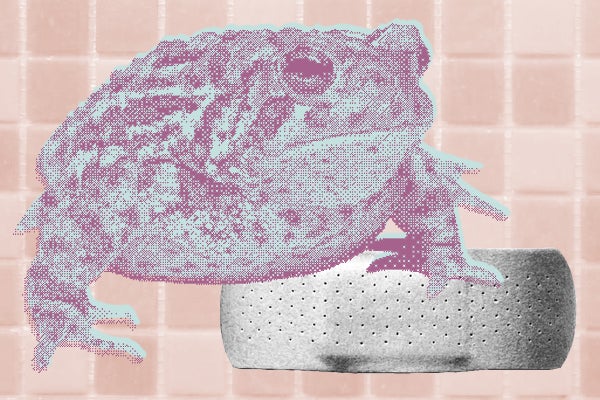 If you’ve learned anything from reading our beauty content over the past few years, you’ll know one thing for sure: Shy we are not. From hair loss tovajazzling, there aren’t many things out there that we won’t discuss. But, it has come to our attention that there are still some subjects out there that many of you feel ashamed to speak out about — so-called “gross” problems like warts, cold sores, dandruff, ingrown toenails, and body hair.
If you’ve learned anything from reading our beauty content over the past few years, you’ll know one thing for sure: Shy we are not. From hair loss tovajazzling, there aren’t many things out there that we won’t discuss. But, it has come to our attention that there are still some subjects out there that many of you feel ashamed to speak out about — so-called “gross” problems like warts, cold sores, dandruff, ingrown toenails, and body hair.
Part of this embarrassment comes from the stigma that surrounds these issues — the unspoken public opinion on them are that they only happen to people who are unclean. We’re here to tell you that is so not true, as these issues can happen to anyone regardless of their grooming routine.
While accepting your body and all of the natural — albeit weird — things that come along with it is righteous, we get that just because you prescribe to the “warts and all” approach to body love doesn’t mean you want to, you know, actually have warts.
So, we’re dropping some truth bombs all over these heretofore taboo topics, so you can learn everything you ever wanted to know about what causes them, how to treat them at home, and if/when you need to get a doc involved. Because if we don’t talk about this stuff, how are we supposed to learn how to deal with it? Ain’t no shame in our beauty game…

Warts
Caused by a viral infection, there are a mind-blowing 134 different types of warts, which makes this a very common beauty woe. They manifest as small, fleshy, grainy bumps that may occur in singles and multiples on the hands, fingers, and feet. According to celebrity dermatologist Dr. Harold Lancer, warts can be transmitted from person to person or by the germs on something you touch — making them nigh on impossible to avoid.
There is some good news, though: Dr. Lancer says they are easy to treat at home with over-the-counter products. Look for ingredients like salicylic acid or dimethyl ether. According to the Mayo Clinic, you should choose one that contains 17% salicylic acid and soak your wart in warm water for 10 to 20 minutes before applying the solution, for maximum benefits. Keep in mind OTC treatments only work on body warts — not on those occurring on the face or genital area. If you’re a DIY kind of gal, there also the duct tape method: Cover your wart with a small piece of duct tape (the plain gray kind, not the clear) for six days, then soak the area in warm water and rub the wart off with an emery board or pumice stone. Results are mixed, but some people swear by this one, so could be worth a shot.
While most warts usually go away on their own, Dr. Lancer says you should consider heading to your doctor if the wart has resisted at-home treatment and has not subsided after two weeks. A doctor will be able to freeze or cut the wart off and get rid of it for good. More good news: However annoying, warts aren’t usually considered hazardous to your health. (One caveat: Dr. Lancer says that if they continue to spread that can be the sign of something more serious, so be sure to get them checked out.)
Dandruff
File this one under things we wish we didn’t know: Those seemingly innocuous white flakes floating off your scalp are caused by a fungus. Hold off on the ew chorus, though, because according to Dr. Rolanda Johnson Wilkerson, senior scientist for P&G Beauty, this fungus —called malessezia globossa — is present in every single one of us. People who get dandruff are just those who have a response to this fungus. “Normal scalp turnover is 21 to 28 days,” says Dr. Wilkerson. “In persons who have a response to the fungus, the skin cellular turnover happens faster — seven to 21 days. The skin initiates an inflammatory response because the skin is reacting to something that is sees as being foreign and is irritating to the skin.” This, according to Dr. Wilkerson, leads to an increased proliferation of skin cells that are not reaching full maturation. That means they don’t properly shed, which results in a build-up of skin cells on the scalp that manifests as dry, white flakes.
In addition to these white flakes, your scalp may also feel irritated, itchy, red, and dry. If you experience dandruff once, chances are you will continue to get it as you are genetically predisposed to be responsive to that fungus. That’s why Dr. Wilkerson says it is imperative to use an anti-dandruff hair care regimen. Look for shampoos and conditioners that contain ZPT (zinc pyrithione), which will inhibit the fungal activity and reduce symptoms. While you should be able to effectively treat dandruff at home, Dr. Wilkerson says you should get in touch with your doc if the problem does not get better with anti-dandruff treatments, or if your flakes are big, yellowish, and oily — this could hint at more serious problems like seborrhoeic dermatitis or psoriasis.

Cold Sores
No tip-toeing around this one: If you get cold sores, it means you’ve picked up the herpes simplex type 1 virus. Unfortunately, some people still don’t know the difference between this one and that other herpes (type 2), hence the stigma. “Since it’s a virus, it does not have to be sexually transmitted in order to be infected,” clarifies Dr. Lancer. “It can be as simple as sharing a drink or lipstick — it can even happen in utero — and appear later.”
But, just because you have the virus doesn’t mean you will always have a cold sore — most of the time, the virus lays dormant until provoked. When a cold sore appears, it will first look like a small gathering of fluid-filled blisters, which will eventually burst open and quickly transform into a large, painful sore on your mouth. They can last for up to two weeks and you may also experience some cold symptoms like fever, muscle aches, sore throat, and headaches.
While there’s no getting rid of cold sores (yet), you can manage and minimize your outbreaks. “Like any virus, a low immune system can’t fight the virus,” says Dr. Lancer, so try to keep the stress levels low, eat healthy, and keep your immune system in tip-top shape. And when those pesky little buggers do crop up, Dr. Lancer recommends treatment creams (Abreva), supplements (lysine), and prescription medication (Valtrex) to shorten the duration and severity of the outbreaks. If this is your first outbreak, or you’ve tried the above treatments and still have a cold sore after 10 days, Dr. Lancer says to head to your doctor asap to make sure everything is okay.
Body Hair
You can thank your hormones for this one — unwanted hair in places like your upper lip, back, or chest can all be linked to hormonal imbalances. According to Dr. Lancer, it means you have too much testosterone in your system. Your diet can also be a culprit as some foods — Dr. Lancer says sushi is a big offender —have excess testosterone in them, which can drive up your natural levels. Conversely, he says nuts and vitamin-rich foods can help balance out hormones.
While it’s easy to remove body hair via tweezers, depilatories, waxes, or laser hair removal, Dr. Lancer says it’s vital to go see a specialist and find out if it is genetics or something else more serious. “Everyone grows hair, but more hair than usual — thicker and growing faster — is a hint that something is off,” he says. “Only a licensed physician can determine if it is just hormonal or something more serious.”
Ingrown Toenails
The one thing you need to know about ingrown toenails? They hurt — a lot. They happen when the corners of your toenails grows into the soft skin adjacent to the nail, which leads to irritation, redness, swelling, pus, and infection. According to podiatrist Dr. Hillary Brenner, there are a wide variety of things that can cause this, including too-narrow shoes, cutting your nails too short or cutting into the corners, dropping something on your toe, running, bad posture, or just your genes.
The best way to prevent ingrown toenails, says Dr. Brenner, is to trim your nails straight across — not in a rounded shape — using straight edge nail clippers. Keep your nails short (but not too short), apply foot cream two times a week to make nails soft and easy to manage, and stay away from shoes or socks that press your feet tightly together.
Once you have an ingrown toenail, you have to be diligent to treat it and keep it from getting worse. “Soak the feet in a basin filled with 1/2 cup of epsom salt, four drops of tea tree oil and 2 1/2 cups of lukewarm water for 10-15 min, once a day for two weeks,” says Dr. Brenner. The epsom salt contains magnesium sulfate, which she says acts as a natural exfoliator and helps relieve swelling and soreness, while tea tree oil acts as an anti-fungal. She also suggests you rub a pea-sized amount of Neosporin on the toenail every day and cover it with a Band-Aid — neomycin, the active ingredient in Neosporin, will act as an antibiotic.
If the ingrown toenail doesn’t improve in a few days or gets worse (read: red streaking up the leg and increasing redness, swelling, odor, and drainage of pus), make an appointment with a podiatrist immediately. He or she can prescribe you an oral antibiotic and remove the offending nail border via a “slant-back” procedure. If after several treatments you are still seeing issues, your doctor may recommend phenol and chemical matrixectomy — this involves numbing the toe, removing the problematic nail border, and applying phenol and alcohol to the nail root to prevent the regrowth of the toenail. Dr. Brenner says this is a permanent nail procedure that should only be performed after several treatments to trim the ingrown toenail have proved unsuccessful. She also notes that once you’ve had any sort of removal, it’s important to follow up with your doctor a few times so they can help retrain the nail to grow back straight and avoid future problems.
Now, aren’t you glad to finally get all of that out in the open? The more you know…
Illustrated by Ammiel Mendoza
Click HERE to read more from Refinery29.

Be the first to comment